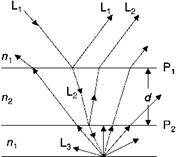The physical background of optical interference effects has been the subject of many publications [5.122-5.125, 5.127-5.130]. The optical principles of pearl luster (interference) pigments are shown in Figure 5.16 for a simplified case of nearly normal
![Optical Principles of Pearl Luster and Interference Pigments Подпись: Tab. 5.13: Overview of inorganic effect pigments. Pigment type Examples Metallic platelets Al, Zn/Cu, Cu, Ni, Au, Ag, Fe (steel), C (graphite) Oxide coated metallic Surface oxidized Cu-, Zn/Cu-platelets, Fe2O3 coated Al- platelets platelets Coated mica platelets* non-absorbing coating: TiO2 (rutile), TiO2 (anatase), ZrO2, SnO2, SiO2 selectively absorbing coating: FeOOH, Fe2O3, Cr2O3, TiO2-x, TiOxNy, CrPO4, KFe[Fe(CN)6], colorants totally absorbing coating: Fe3O4, TiO, TiN, FeTiO3, C, Ag, Au, Fe, Mo, Cr, W Platelet-like monocrystals BiOCl, Pb(OH)2 2 PbCO3, a-Fe2O3, a-Fe2O3 x n SiO2, AlxFe2-XO3, MnyFe2-yO3, AlxMnyFe2-x-yO3, Fe3O4, reduced mixed phases, Cu-phthalocyanine Comminuted thin PVD-films Al, Cr (semitransp.)/SiO2/Al/SiO2/Cr (semitransp.) * Instead of mica other platelets such as silica, alumina, or borosilicate can be used.](/img/1206/image100.png) |
incidence without multiple reflection and absorption. At the interface Pi between two materials with refractive indices n1 and n2, part of the beam light L1 is reflected (L1′) and part is transmitted (i. e., refracted) (L2). The intensity ratios depend on n1 and n2. In a multilayer arrangement, as found in pearl or pearl luster and iridescent materials (Figure 5.15D), each interference produces partial reflection. After penetration through several layers, depending on the size of and difference between n1 and n2, virtually complete reflection is obtained, provided that the materials are sufficiently transparent.
 Fig. 5.16 Simplified diagram showing nearly normal incidence of a beam of light (L1) from an optical medium with refractive index П1 through a thin solid film of thickness d with refractive index n2. L1 ’ and L2’ are regular reflections from phase boundaries P1 and P2. L3 represents diffuse scattered reflections from the transmitted light.
Fig. 5.16 Simplified diagram showing nearly normal incidence of a beam of light (L1) from an optical medium with refractive index П1 through a thin solid film of thickness d with refractive index n2. L1 ’ and L2’ are regular reflections from phase boundaries P1 and P2. L3 represents diffuse scattered reflections from the transmitted light.
In pigments that simulate natural pearl effects, the simplest case is a plateletshaped particle with two phase boundaries P1 andP2 at the upper and lower surfaces of the particles, i. e., a single, thin, transparent layer of a material with a higher refractive index than its surroundings. For small flakes with a thickness of ca. 100 nm, the physical laws of thin, solid, optical films apply.
Multiple reflection of light on a thin solid film with a high refractive index causes interference effects in the reflected light and in the complementary transmitted light. For the simple case of nearly perpendicular incidence, the intensity of the reflectance (I) depends on the refractive indices (n1, n2), the layer thickness (d), and the wavelength (A):
I _ A2 + B2 + 2AB cos 0 _ 1+ A2B2 + 2AB cos 0
ЛУП, 1 n1 — n2 D n2 — П1 „ . n-2 d
Where A _———— , B _————- , 0 _ 4
n2 +n1 n2 + n1 A
With given n1 and n2 the maximum and minimum intensities of the reflected light, seen as interference colors, can be calculated and agree well with experimental results. Values for the refractive indices of the most important materials for pearl luster pigments are shown in Table 5.14.
|
Tab. 5.14: Refractive indices of materials.
|
In practice, platelet crystals are synthesized with a layer thickness d calculated to produce the desired interference colors (iridescence). Most pearl luster pigments now consist of at least three layers of two materials with different refractive indices. Thin flakes (thickness ca. 500 nm) of a material with a low refractive index (mica, silica, alumina, glass) are coated with a highly refractive metal oxide (TiO2, Fe2O3, layer thickness ca. 50-150 nm). This results in particles with four interfaces that constitute a more complicated but still predictable thin film system. The behavior of more complex multilayer pigments containing additional, thin, light-absorbing films can also be calculated if appropriate optical parameters are known.
Color effects depend on the viewing angle. Pearl luster pigment platelets split white light into two complementary colors that depend on the platelet thickness. The reflected (interference) color dominates under regular (maximum) reflection, i. e., when the object is observed at the angle of regular reflection. The transmitted part dominates at other viewing angles under diffuse viewing conditions, provided that there is a non-absorbing (white) or reflecting background. Variation of the viewing angle therefore produces a sharp gloss (reflectance) peak, and the color changes between two extreme complementary colors. The resulting complex interplay of luster and color is measured goniophotometrically in reflection and at different angles. A pearl luster pigment is characterized by a minimum of three L*a*b* data sets (CIE L*a*b*-system) measured under different conditions (e. g., 0°/45° black background, 22.5°/22.5° black background, 0°/45° white background). An analysis of these data specifies a pigment on the basis of its hiding power, luster, and hue [5.122, 5.131, 5.132].
Against a black background or in a blend with carbon black, the transmitted light is absorbed and the reflected interference color is seen as the mass tone (i. e., overall color) ofthe material. In blends ofnacreous pigments with absorbing colorants, the particle size of the latter must be well below the scattering limit, i. e., they must be transparent. The nacreous effect or iridescent reflection is otherwise quenched by the hiding pigments. This also applies to blends with strongly reflecting metal effect pigments (e. g., aluminum). Blends of pigments with different interference colors obey an additive mixing law, (e. g., blue + yellow = green).
5.3.1.3
 3 января, 2016
3 января, 2016  Pokraskin
Pokraskin  Опубликовано в рубрике
Опубликовано в рубрике 